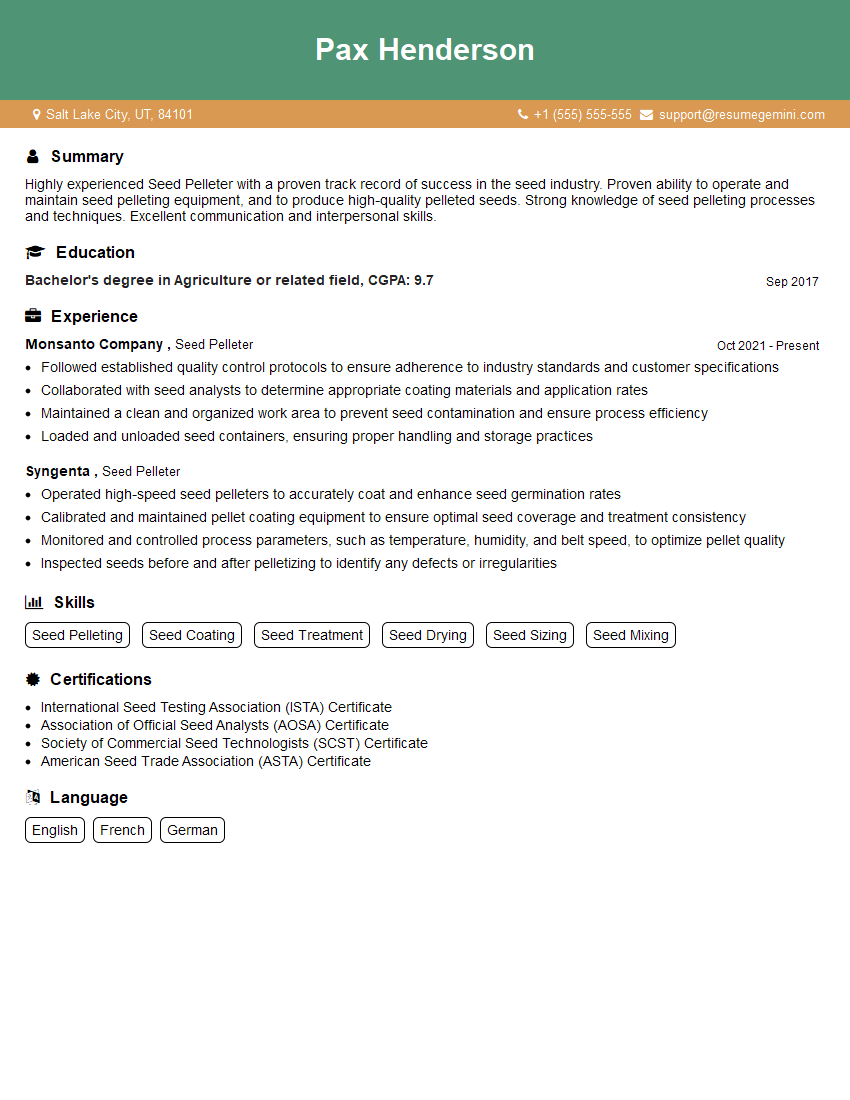Are you a seasoned Seed Pelleter seeking a new career path? Discover our professionally built Seed Pelleter Resume Template. This time-saving tool provides a solid foundation for your job search. Simply click “Edit Resume” to customize it with your unique experiences and achievements. Customize fonts and colors to match your personal style and increase your chances of landing your dream job. Explore more Resume Templates for additional options.

Pax Henderson
Seed Pelleter
Summary
Highly experienced Seed Pelleter with a proven track record of success in the seed industry. Proven ability to operate and maintain seed pelleting equipment, and to produce high-quality pelleted seeds. Strong knowledge of seed pelleting processes and techniques. Excellent communication and interpersonal skills.
Education
Bachelor’s degree in Agriculture or related field
September 2017
Skills
- Seed Pelleting
- Seed Coating
- Seed Treatment
- Seed Drying
- Seed Sizing
- Seed Mixing
Work Experience
Seed Pelleter
- Followed established quality control protocols to ensure adherence to industry standards and customer specifications
- Collaborated with seed analysts to determine appropriate coating materials and application rates
- Maintained a clean and organized work area to prevent seed contamination and ensure process efficiency
- Loaded and unloaded seed containers, ensuring proper handling and storage practices
Seed Pelleter
- Operated high-speed seed pelleters to accurately coat and enhance seed germination rates
- Calibrated and maintained pellet coating equipment to ensure optimal seed coverage and treatment consistency
- Monitored and controlled process parameters, such as temperature, humidity, and belt speed, to optimize pellet quality
- Inspected seeds before and after pelletizing to identify any defects or irregularities
Certificates
- International Seed Testing Association (ISTA) Certificate
- Association of Official Seed Analysts (AOSA) Certificate
- Society of Commercial Seed Technologists (SCST) Certificate
- American Seed Trade Association (ASTA) Certificate
Languages
- English
- French
- German
Career Expert Tips:
- Select the ideal resume template to showcase your professional experience effectively.
- Master the art of resume writing to highlight your unique qualifications and achievements.
- Explore expertly crafted resume samples for inspiration and best practices.
- Build your best resume for free this new year with ResumeGemini. Enjoy exclusive discounts on ATS optimized resume templates.
How To Write Resume For Seed Pelleter
- Highlight your experience and skills in seed pelleting.
- Showcase your knowledge of seed pelleting processes and techniques.
- Emphasize your ability to operate and maintain seed pelleting equipment.
- Demonstrate your commitment to quality and safety.
Essential Experience Highlights for a Strong Seed Pelleter Resume
- Operate and maintain seed pelleting equipment
- Produce high-quality pelleted seeds
- Monitor seed pelleting processes and make adjustments as needed
- Ensure that all seed pelleting operations are conducted in accordance with company standards
- Troubleshoot and resolve problems with seed pelleting equipment
- Maintain a clean and organized work area
- Follow all safety procedures
Frequently Asked Questions (FAQ’s) For Seed Pelleter
What is seed pelleting?
Seed pelleting is the process of coating seeds with a thin layer of material. This coating can improve seed germination, emergence, and vigor. Seed pelleting can also be used to protect seeds from pests and diseases.
What are the benefits of seed pelleting?
Seed pelleting can provide a number of benefits, including: improved seed germination, emergence, and vigor; protection from pests and diseases; and improved seed handling and storage.
What materials are used for seed pelleting?
A variety of materials can be used for seed pelleting, including: polymers, clays, and organic materials. The choice of material will depend on the specific needs of the seed and the desired results.
How is seed pelleting done?
Seed pelleting is typically done using a?????. The seed is first coated with a thin layer of the material, and then the coating is allowed to dry.
What are the different types of seed pelleting?
There are two main types of seed pelleting: precision pelleting and standard pelleting. Precision pelleting is a more precise process that results in a more uniform coating. Standard pelleting is a less precise process that results in a less uniform coating.
What is the future of seed pelleting?
The future of seed pelleting is promising. As the demand for high-quality seeds continues to grow, seed pelleting will become increasingly important. Seed pelleting can help to improve seed quality, protect seeds from pests and diseases, and improve seed handling and storage.